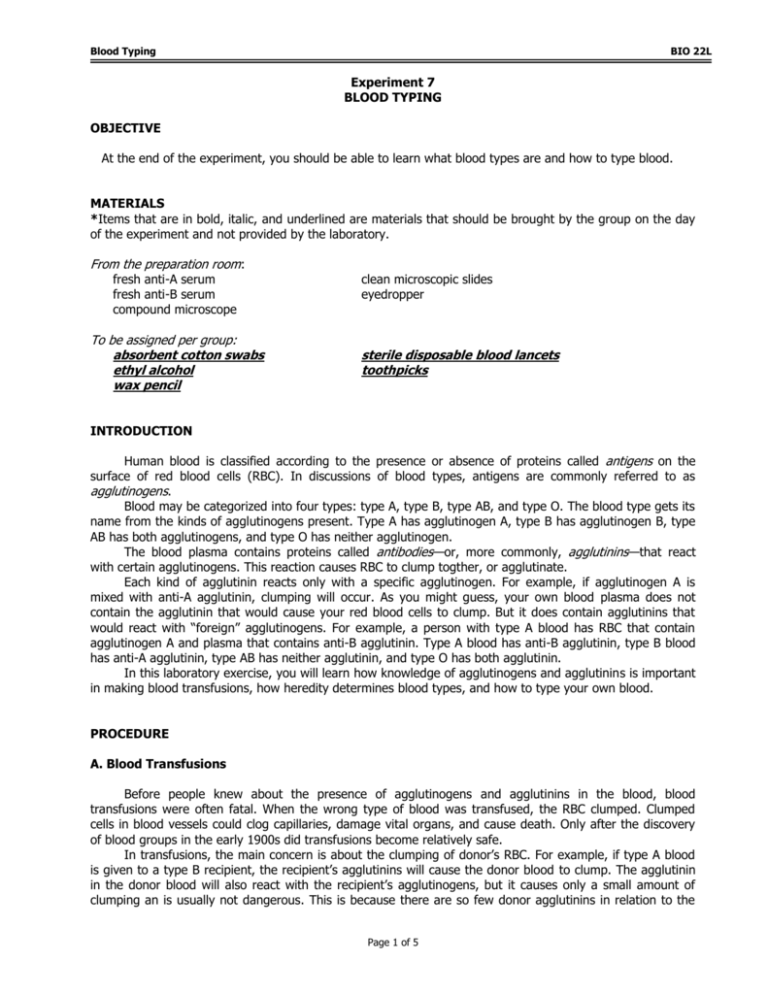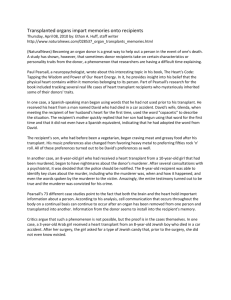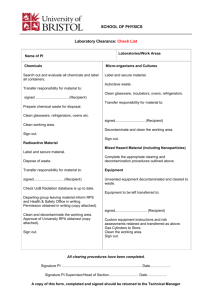Blood Typing
advertisement

Blood Typing BIO 22L Experiment 7 BLOOD TYPING OBJECTIVE At the end of the experiment, you should be able to learn what blood types are and how to type blood. MATERIALS *Items that are in bold, italic, and underlined are materials that should be brought by the group on the day of the experiment and not provided by the laboratory. From the preparation room: fresh anti-A serum fresh anti-B serum compound microscope To be assigned per group: absorbent cotton swabs ethyl alcohol wax pencil clean microscopic slides eyedropper sterile disposable blood lancets toothpicks INTRODUCTION Human blood is classified according to the presence or absence of proteins called antigens on the surface of red blood cells (RBC). In discussions of blood types, antigens are commonly referred to as agglutinogens. Blood may be categorized into four types: type A, type B, type AB, and type O. The blood type gets its name from the kinds of agglutinogens present. Type A has agglutinogen A, type B has agglutinogen B, type AB has both agglutinogens, and type O has neither agglutinogen. The blood plasma contains proteins called antibodies—or, more commonly, agglutinins—that react with certain agglutinogens. This reaction causes RBC to clump togther, or agglutinate. Each kind of agglutinin reacts only with a specific agglutinogen. For example, if agglutinogen A is mixed with anti-A agglutinin, clumping will occur. As you might guess, your own blood plasma does not contain the agglutinin that would cause your red blood cells to clump. But it does contain agglutinins that would react with “foreign” agglutinogens. For example, a person with type A blood has RBC that contain agglutinogen A and plasma that contains anti-B agglutinin. Type A blood has anti-B agglutinin, type B blood has anti-A agglutinin, type AB has neither agglutinin, and type O has both agglutinin. In this laboratory exercise, you will learn how knowledge of agglutinogens and agglutinins is important in making blood transfusions, how heredity determines blood types, and how to type your own blood. PROCEDURE A. Blood Transfusions Before people knew about the presence of agglutinogens and agglutinins in the blood, blood transfusions were often fatal. When the wrong type of blood was transfused, the RBC clumped. Clumped cells in blood vessels could clog capillaries, damage vital organs, and cause death. Only after the discovery of blood groups in the early 1900s did transfusions become relatively safe. In transfusions, the main concern is about the clumping of donor’s RBC. For example, if type A blood is given to a type B recipient, the recipient’s agglutinins will cause the donor blood to clump. The agglutinin in the donor blood will also react with the recipient’s agglutinogens, but it causes only a small amount of clumping an is usually not dangerous. This is because there are so few donor agglutinins in relation to the Page 1 of 5 Blood Typing BIO 22L great volume of the recipient’s blood. So, in general, it is clumping of the donor’s—not the recipient’s—blood that can cause harm. To prevent clumping, the medical staff determines the blood types of the donor and recipient before doing a transfusion. For example, a type A recipient can safely receive a transfusion of either type A or O blood. The type A recipient should not receive either type B or AB blood because the recipient’s anti-B agglutinin would cause clumping of type B and type AB red blood cells in the donor blood. Complete Table 8.1 in the report sheet. Remember, be concerned only about the effect of the recipient’s agglutinins on the donor’s agglutinogens. B. Genotypes of Blood Groups Blood types are determined by the genes. Genes for a trait usually occur in only two alternate versions called alleles, one of which is dominant and one of which is recessive. Some traits, however, have multiple alleles. There are three alleles for blood type: A = allele producing agglutinogen A B = allele producing agglutinogen B O = allele producing no agglutinogen The type A and B alleles are dominant and the O is recessive. When the type A and the B alleles occur together in a genotype they are codominant and produce both A and B agglutinogens. On Table 8.2, write all the possible genotypes for each blood group. The possible genotypes are: AA, AO, BB, BO, AB, and OO. C. Typing Your Blood You can determine your blood type by performing a simple laboratory test. With a wax pencil, draw a line across the middle of a clean slide, dividing in half. Label the halves A and B. Wash your hands with soap and water, then dry them. Dip a cotton swab in alcohol and use it to clean the third fingertip of your left hand. With your left thumb, stroke this finger in an upward direction three times. This forces the blood to your fingertip. On the final stroke, hold your thumb near the fingertip and press down. With an unused sterile lancet, puncture your fingertip. Caution: Do not use a lancet that someone else has already used. The lancet must be sterile. Put one drop of blood in box A on your slide and one drop in box B. Immediately dispose your lancet so that no one else will use it. Place one drop of anti-A serum (colored blue) on the blood in box A. Mix the blood and serum wit a clean toothpick. Dispose of the toothpick immediately after use. Place a drop of anti-B serum in the blood in box B. Mix with a clean toothpick and then dispose of the toothpick. Caution: Do not let the dropper touch the blood, or get serum on your fingers. For three minutes, slowly tilt the slide back and forth to keep the solutions in motion. Be careful not to let the liquids in box A and in box B mix. Watch for clumping. Observe the slide under low power with a compound microscope (optional: If you wish to use high power, add a coverslip to the slide). Draw in Figure 8.1 the pattern of blood clumping you have observed under the microscope. Clumped blood cells in box A indicate the presence of agglutinogen A. Clumping in box B indicates the presence of agglutinogen B. If there is no clumping in either box, neither agglutinogen is present. Collect blood type data from the entire class and calculate the percentages of each type in the class. Enter your data on Table 8.3. Page 2 of 5 Blood Typing BIO 22L NAME (SN, GN, MI) ______________________________ DATE PERFORMED _________________________ SUBJECT/SECTION ______________________________ DATE SUBMITTED _________________________ INSTRUCTOR ___________________________________ RATING __________________________________ Report for Experiment 8 Blood Typing A. Blood Transfusions Table 8.1 Blood type of recipient with blood types of possible donor Blood Type of Recipient Blood Types of Possible Donor A B AB O Table 8.2 Possible genotypes for each blood group Blood Type (Phenotype) Agglutinogen Agglutinin A A anti-B B B anti-A AB A, B none O none anti-A, anti-B Blood Types of Possible Donor Figure 8.1 Blood clumping pattern observed under the microscope after addition of anti-A and anti-B serum A B Table 8.3 Collection of blood type data from the entire class Blood Types Number of Students with Blood Type A B AB Page 3 of 5 Percentage of Class with Blood Types Blood Typing BIO 22L O QUESTIONS TOTAL 100% 1. According to Table 8.1, what blood type does a universal donor have? Why would this type not be clumped by other blood types? Explain. _________________________________________________________________________________ _________________________________________________________________________________ 2. With reference to Table 8.1, what blood type does a universal recipient have? Why would this type not cause clumping of other types? Explain. _________________________________________________________________________________ _________________________________________________________________________________ 3. What is your blood typed as indicated in the result in Figure 8.1? _________________________________________________________________________________ _________________________________________________________________________________ ANALYSIS 4. The approximate frequencies of blood types found in the population of the United States are as follows: Blood Type Frequency (%) A B AB O 46 40 10 4 Are the US data fairly close to the class data (within 5-10 per cent)? If you have determine blood types for the whole school, would the school data be closer than the class data to the US data? Explain your answer. _________________________________________________________________________________ _________________________________________________________________________________ _________________________________________________________________________________ 5. If you were married to a person with type A blood, what blood types could your children have? Your Blood Type Spouse Blood Type Children Blood Types A 6. If you were married to a person with type O blood, what blood types could your children have? Your Blood Type Spouse Blood Type O Page 4 of 5 Children Blood Types Blood Typing BIO 22L 7. Mr. and Mrs. Pura have type A blood. Mrs. Pura gives birth to a baby delivered by bumbling old Dr. Inesin. Dr. Inesin mixes up the Pura baby with two others. Baby Kharl has type B blood. Baby Karen has type O blood. Baby Jun has type AB blood. Which baby belongs to the Puras? Show the possible genotypes of the parents and the offspring. 8. Mr. and Mrs. Zaballero have type A and type B blood, respectively. Baby Rose has type A blood. Baby Frank has type B blood. Baby Fordz has type O blood. Which baby could be theirs? Show the possible genotypes of the parents and the offspring. 9. Which statement is more nearly correct? Explain your choice. A. By finding the blood types of parents and a baby, it is possible to determine that the baby is their offspring. B. By finding the blood types of parents and a baby, it is possible to determine that the baby is NOT their offspring. _________________________________________________________________________________ _________________________________________________________________________________ _________________________________________________________________________________ 10. What is the inherited blood type Rh factor? What does it mean when a person is Rh-positive? Rhnegative? Explain the significance of knowing the type of Rh factor an individual may have. _________________________________________________________________________________ _________________________________________________________________________________ _________________________________________________________________________________ CONCLUSION ___________________________________________________________________________ ___________________________________________________________________________ ___________________________________________________________________________ REFERENCES (In standard bibliographic format) Page 5 of 5







